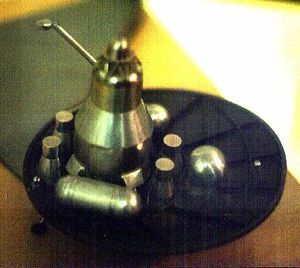
Home - Search - Browse - Alphabetic Index: 0- 1- 2- 3- 4- 5- 6- 7- 8- 9
A- B- C- D- E- F- G- H- I- J- K- L- M- N- O- P- Q- R- S- T- U- V- W- X- Y- Z
MEK
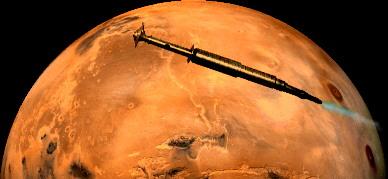
Aelita Mars Exped.
Aelita Mars Expedition
Credit: © Mark Wade
AKA: Mars Expeditionary Complex. Status: Study 1969. Thrust: 61 N (14 lbf). Gross mass: 150,000 kg (330,000 lb). Specific impulse: 8,000 s. Height: 175.00 m (574.00 ft). Span: 17.00 m (55.00 ft).
Primary spacecraft propulsion was to be 15 MW nuclear-electric engines with liquid fuel auxiliaries.
In the post-Apollo moon landing euphoria, NASA was pressing for funding for a manned expedition to Mars. The Soviet leadership reacted in kind. Development of an advanced project for the MK-700 was authorized in Ministry of Defense decree 232 of 30 June 1969. The TTZ specification document was written by the TsNIIMASH and NIITI institutes, and the project was given the code name 'Aelita'. Three design bureaus, led by chief designers Mishin, Yangel, and Chelomei, began competitive design of manned Mars expeditions.
On 28 May 1969 V Mishin, Korolev's successor as Chief Designer of OKB-1, had approved development of the N1M advanced version of the N1 launch vehicle. Feoktistov was tasked with preparing the OKB-1 version of Project Aelita and creating a design that would take advantage of the increased lift of the N1M. This spacecraft was called the Mars Expeditionary Complex (MEK). The MEK was designed to take a crew of from three to six to Mars and back with a total mission duration of 630 days; stay in Mars orbit of 30 days; landing three of the crew on the surface for five to seven days. Primary spacecraft propulsion was to be 15 MW nuclear-electric engines with liquid fuel auxiliaries.
By the end of 1969 Mishin and Yangel dropped out of the competition. This left Chelomei as the only chief designer working on Project Aelita.
The MEK was 175 m long with a maximum span of 17 m. It consisted of, from fore to aft:
- Mars Landing Craft (MPK) for landing on the Martian surface. The MPK had an open aeroshell for aerodynamic braking with a sophisticated, asymmetrical, high-lift configuration. After separation from the MEK, the MPK would drop its docking apparatus. After aerodynamic deceleration in the Martian atmosphere the MPK's liquid rocket landing engine would brake the spacecraft to a soft landing on the surface. Arranged within the aeroshell were a cylindrical dwelling section, an airlock/transition section, and the ascent stage with its spherical cabin. The MPK was 11 m in diameter, 8.5 m high, and had a mass of around 20 metric tons.
- Mars Orbit Spacecraft (MOK), including crew quarters and basic on-board systems. This differed from the earlier TMK designs in being 4.1 m in diameter and 23 m long (versus the 6 m diameter of the TMK). Mass was around 40 metric tons. From fore to aft the MOK consisted of:
- Instrumentation cluster, including docking ports for the VA and MPK
- Working compartment
- Laboratory compartment
- Biotechnical compartment
- Living compartment
- Crew salon
- Engine section, including orientation engines, and in one version, the ion engines at the center of gravity of the spacecraft
- Recovery Apparatus (VA) in which the six crew would land on earth after the flight back from Mars. This was an enlarged form of the Soyuz 'headlight' re-entry capsule shape with a mass of 10 metric tons. The VA would have a hypersonic lift to drag ration of 0.45 to minimize G-loads on return. It would have a basic diameter of 4.35 m, a height of 3.15 m, and a lens-shaped base shield of 6 m diameter. The VA was docked to a lateral port of the MOK just aft of the MPK. In an alternate scenario with three crew a Soyuz 7K-L1, which would dock with the MEK after it cleared the radiation belts, would be used as the return capsule.
- Large disk-shaped radiation shield, to protect the crew areas from the nuclear reactor which powered the engines
- Two long thin thermionic radiator booms (or in the variant shown in a model at TsNIIMASH, a telescoping series of cylinders), which were deployed after launch to move the power reactor away from the rest of the spacecraft
- Energy-engine Section (YaERDU. This consisted of the engine propellant tank (with about 25 metric tons propellant), the engine block, the liquid lithium reactor cooling system, and two YaE-2 nuclear reactors with a total output of 15,000 kW. Total thrust would be 6.2 kgf at a specific impulse of 8000 seconds
The 150 metric ton MEK would be assembled in two launches of the N1M. The first launch would put the MOK and MPK in to low earth orbit. The second would place the YaERDU into a nearby orbit, after which it would automatically dock with the MOK /MPK section. Still unmanned in one variant, the MEK would begin its slow acceleration spiral away from the Earth. In the three-crew version, after the MEK had cleared the Earth's radiation belts, the crew would be launched aboard a Soyuz 7K-L1 / Block D complex by a Proton booster. The Soyuz would rendezvous and dock with the MEK in high earth orbit.
The MEK would continue to slowly accelerate until it reached earth escape velocity. The crew would have plenty of time to fully check out the systems and abandon ship in their Soyuz or VA lifeboat if any problems developed before Earth escape. After reaching Mars trajectory velocity, the ion engines would shut down and the nuclear reactor would go into a low power coast / spacecraft power generation mode. After 135 days of coasting flight, the engines would begin operating again, taking 61 days to brake into a high Mars orbit and then a further 24 days to spiral into a low polar Mars orbit.
After a week of reconnaissance from orbit, three of the crew would enter the MPK and head for the selected landing site on the Martian surface. Following completion of a week's surface studies, the crew would be boosted into Martian orbit by the MPK ascent stage, and then automatically rendezvous and dock with the MOK. After a further period of studies from orbit, the MEK's ion engines would be restarted and the acceleration spiral away from Mars would begin. It would take 17 days to escape Mars, and the engine would accelerate the MOK for another 66 days until it was placed on a fast Earth return orbit, passing between the orbits of Venus and Mercury. The engine would be restarted for a 17-day brake maneuver at perihelion to reduce approach speed with the earth. After a short coast, the engine would be restarted a final time to brake the complex prior to the separation of the VA landing capsule for return to the Earth of the crew and their Martian samples.
By the end of 1969 Mishin and Yangel dropped out of the competition. At OKB-1 it was felt that a more gradual approach would be more in keeping with state resources. First the N1 launch vehicle, as yet unproven, had to be fully developed. Then the TMK should be thoroughly tested and developed in Earth Orbit. This could be followed by a simple Mars fly by expedition. The MEK or its successor would be left for the next Century.
MEK Mission Summary:
- Summary: Final Soviet nuclear-electric Mars expedition design.
- Propulsion: Nuclear electric
- Braking at Mars: propulsive
- Mission Type: low acceleration
- Split or All-Up: all up
- ISRU: no ISRU
- Launch Year: 1980
- Crew: 3
- Outbound time-days: 300
- Mars Stay Time-days: 30
- Return Time-days: 300
- Total Mission Time-days: 630
- Total Payload Required in Low Earth Orbit-metric tons: 150
- Total Propellant Required-metric tons: 24
- Propellant Fraction: 0.16
- Mass per crew-metric tons: 50
- Launch Vehicle Payload to LEO-metric tons: 75
- Number of Launches Required to Assemble Payload in Low Earth Orbit: 2
- Launch Vehicle: N1M
Crew Size: 6. Electric System: 15,000.00 average kW.
Family: Mars Expeditions. Country: Russia. Launch Vehicles: Mars tactical rocket, N1, N1 1969. Propellants: Electric/Xenon. Agency: Korolev bureau. Bibliography: 193, 206, 89.
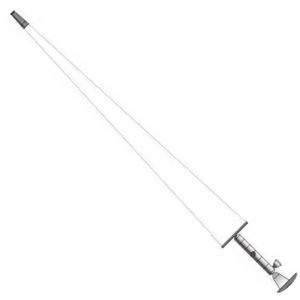 | MEK - Different vers MEK Mars Expedition Spacecraft of 1969, layout as published by RKK Energia in 1999. Credit: © Mark Wade |
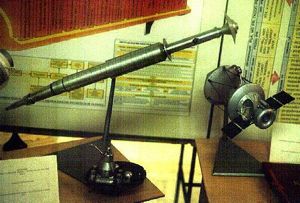 | Aelita - MEK On the left, the OKB-1 Aelita Mars spacecraft that would be launched into near-Earth orbit using the N1M launch vehicle. Credit: © Mark Wade |
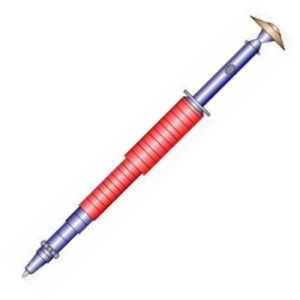 | Aelita / MEK Aelita / MEK Manned Mars Expedition Credit: © Mark Wade |
 | MEK Spacecraft RKK Energia drawing of the 1969 MEK Mars expedition spacecraft. |
 | Aelita Mars Ship Aelita Mars Spacecraft Credit: © Mark Wade |
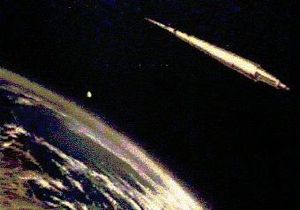 | Aelita MEK The Aelita MEK releases a lander from Mars orbit. Frame from an RKK Energia film that combines the MEK orbiter with the EA lander proposed in the late 1970's. Credit: RKK Energia |
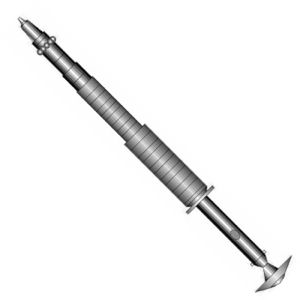 | MEK - per Model at T MEK Mars Expedition Spacecraft of 1969, layout as represented by the model on display at TsNIIMASH. Credit: © Mark Wade |
Back to top of page
Home - Search - Browse - Alphabetic Index: 0- 1- 2- 3- 4- 5- 6- 7- 8- 9
A- B- C- D- E- F- G- H- I- J- K- L- M- N- O- P- Q- R- S- T- U- V- W- X- Y- Z
© 1997-2019 Mark Wade - Contact
© / Conditions for Use
